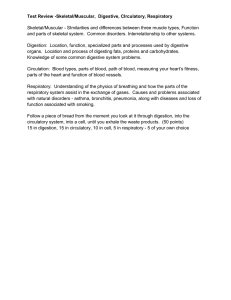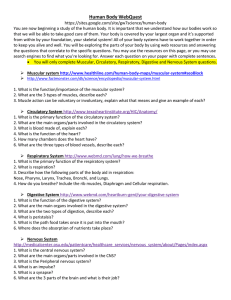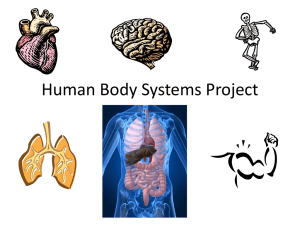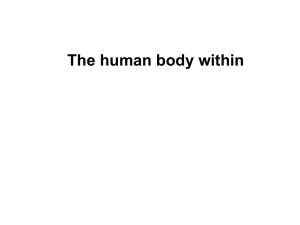Human Body Systems
advertisement
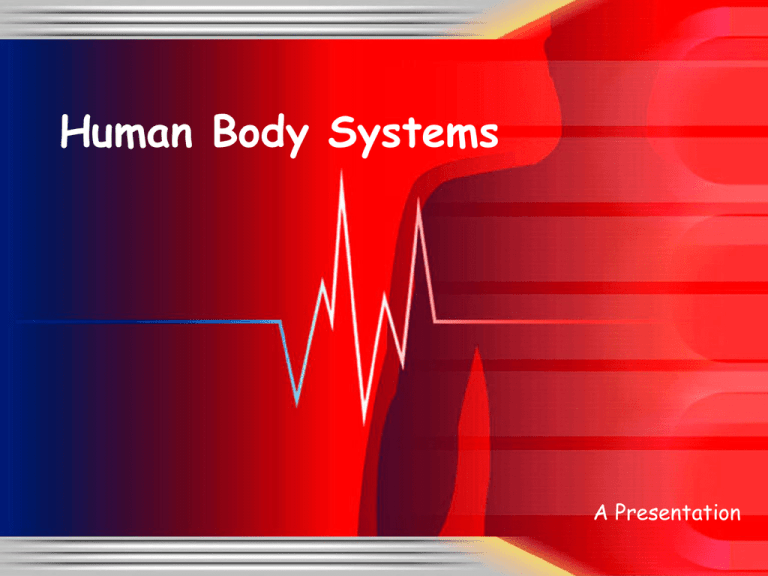
Human Body Systems A Presentation SKELETAL SYSTEM Skeletal System Functions: 1. Protects vital organs 2. Gives our bodies a shape 3. Allows our bodies to move Skeletal System Major Components: 1. Bones- Rigid organs that form the endoskeleton of vertebrate animals 2. Cartilage-Stiff yet flexible tissue that connects different parts of the body. (ears, knees, discs of vertebrae, etc. 3. Ligaments- Loosely attach bones to muscle 4. Joints- The place where two or more bones make contact (knees, fingers, elbows) Skeletal System Interesting Facts: 1. Humans and giraffes have the same number of bones in their necks. Giraffes just have longer bones. 2. Humans have over 230 moveable and semi-moveable joints 3. The longest bone in your body is your femur. It is about ¼ of your total height. MUSCULAR SYSTEM Muscular System Functions: 1. Supports and enables body movement 2. Produces heat 3. Helps give the body its overall shape Muscular System Major components: 1. Skeletal Muscle- Voluntary muscle attached to bone. 2. Cardiac Muscle- Involuntary muscle of the heart and circulatory system 3. Smooth Muscle- Involuntary muscle found in respiratory system, urinary system, digestive system, reproductive system Muscular System Interesting Facts: 1. You have over 30 facial muscles which create looks like surprise, happiness, sadness, and frowning. 2. Eye muscles are the busiest muscles in the body. Scientists estimate they may move more than 100,000 times a day! 3. The largest muscle in the body is the gluteus maximus muscle in the buttocks. Circulatory System Functions: 1. Carries oxygen, carbon dioxide, nutrients, and wastes throughout the body. Circulatory System Major Components: 1. Heart- Muscular organ which pumps blood throughout blood vessels through repeated contractions. 2. Arteries-Carry blood away from the heart 3. Veins- Carry blood towards the heart 4. Capillaries- Smallest blood vessels located between arteries and veins. Where the exchange of water, oxygen, carbon dioxide, wastes and nutrients between blood and the surrounding tissue takes place. Circulatory System Major Components: 4. Blood- A mixture of RBC’s, WBC’s, and plasma that carries oxygen, carbon dioxide, wastes, and nutrients throughout the body 5. Red Blood Cells- Contains hemoglobin, carries oxygen and carbon dioxide throughout the body 6. White Blood Cells- Protects the body again foreign pathogens (bacteria/viruses) 7. Plasma- The fluid component of blood Circulatory System Interesting Facts: 1. The body of an adult contains over 60,000 miles of blood vessels! 2. An adult's heart pumps nearly 4000 gallons of blood each day! 3. Your heart beats some 30 million times a year! 4. The average three-year-old has two pints of blood in their body; the average adult at least five times more! 5. A "heartbeat" is really the sound of the valves in the heart closing as they push blood through its chambers. RESPIRATORY SYSTEM Respiratory System Functions: 1. To supply the blood with oxygen so that it may deliver oxygen to all parts of the body. Respiratory System Major components: 1. Nose- The location which admits and expels air for respiration 2. Trachea- The windpipe tube that connects the lungs to the pharynx 3. Lungs- Transports O2 from the atmosphere into the blood and CO2 from the blood into the atmosphere. Respiratory System Major Components: 4. Alveoli- Specialized cells found within the lungs where gas exchange takes place. (O2 is added to blood, CO2 is removed from blood) 5. Diaphragm- A thin muscle which when contracted allows air to enter the body; and when relaxed expels (releases) air out of the body. Respiratory System Interesting Facts: 1. Your lungs contain almost 1500 miles of airways and over 300 million alveoli. 2. Every minute you breathe in 13 pints of air. 3. Plants are our partners in breathing. We breathe in air, use the O2 in it, and release CO2. Plants do the opposite. 4. People get more colds in the winter because they are indoors more often and in close proximity to other people. When people sneeze, cough and even breathe -- germs go flying! DIGESTIVE SYSTEM Digestive System Function: 1. Breaks down food; either physically or chemically 2. Processes food for use by the body 3. Excretes waste products Digestive System Components: 1.) Mouth/Teeth- The 1st organs of the digestive tract. • The teeth are bones whose main purpose is to grind food into bits that the body can digest. • Saliva helps begin to break down food Digestive System Components: 2.) Esophagus- Tube that pushes food from the pharnyx to the stomach. 3.) Stomach- Secretes protein-digesting enzymes that aid in the chemical breakdown of food. 4.) Small Intestines-The organ in which most of digestion occurs. It is the place where carbohydrates are broken down and nutrients are absorbed. Digestive System Components: 5.) Large Intestines- Removes water from the undigested food and passes remaining waste from the body. Digestive System Interesting Facts: 1. 2. 3. 4. 5. 6. 7. 8. 9. Intestines are at least 25 feet in an adult. Chewing food takes from 5-30 seconds Swallowing takes about 10 seconds Food sloshing in the stomach can last 3-4 hours It takes 3 hours for food to move through the intestine Food drying up and hanging out in the large intestine can last 18 hours to 2 days! Americans eat about 700 million pounds of peanut butter. Americans eat over 2 billion pounds of chocolate a year. In your lifetime, your digestive system may handle about 50 tons of food matter. NERVOUS SYSTEM Nervous System Function: 1.) Gathers and interprets information and responds to that information Nervous System Major Components: 1.) Brain- The brain controls how our bodies work. – The brain makes sure our hearts keep beating and our lungs keep working without us having to think about it. – It makes our muscles work. – It also allows us to think, see, hear, feel and taste. Nervous System Major Components: 2.) Spinal Cord- The spinal cord joins the brain at the top of our neck. Its main function is to serve as a pathway for the messages from the nerves to travel to the brain and back so we know what we are seeing, touching, hearing, and tasting, and if something hurts or feels. Nervous System Major Components: 3.) Nerves send messages to and from the spinal cord which send messages to and from our brain.

